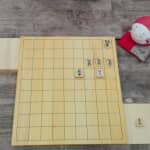Shogi 23 January 2017
An Easy Game with Shogi – Create a Formation with tactful “Kiki”–
It is quite difficult to master piece-movement and it’s ability, isn’t it?
Once you memorize all of the pieces’ movements, you don’t feel it’s not very difficult thing. However, I notice there are many children who get confused with the difference between the movements of Gin (or Siliver) and Kin (or Gold) and with the movement of Kei (or Knight). Children are not to be blamed, since piece-movement abilities are quite virtual thing. Actually, it’s not easy to remember virtual movements. When you want to make invisible things visible in your imagination, you need decent amount of training.

Then, I would like to introduce our original puzzles enhancing your understanding about piece-movement abilities. This enables ideal practices to visualize potential moving abilities in your head.

Moreover, we, I-tus-tsu are aimed for popularizing Shogi with a motto, “More enjoyable, and easier for children”. We observe the point that rules of the puzzles should be easy enough for ones who want to play Shogi, so that they can remember them on the same day of their starts.
Highlighting each piece-movement, we hope our puzzles help you to learn basic piece-movements; the more you work through our puzzles, the deeper you could get the hang of piece-movements.
By the way, for children who are struggling to memorize piece-movements, we created a cute and practical mat figuring instructions of movements.
We are going to provide seven puzzles here, give them a good try!
Rules
Just friendly reminder, “Kiki”, is the ability of a piece to be able to move to a specific square; If a square on a board has one Kiki, there are one piece with a possibility to move to the square.
Try to create the same number of Kiki as the number described in a square of 3×3 base on a board. You can make any number of Kiki to any square having no numbers.
Practice
Practice 1:

Tip: Remember, Fu or Pawn always make Kiki to one square in front of itself. Taking this into account, let’s drop pieces from a piece stand.
Practice 2:

Tip: Gin or Silver generate Kiki along a diagonal line. Try out to figure out all 4 different answers.
Practice 3:

Tip: Do you remember how Kin (or Gold) and Gin (or Silver) can move? The difference between their movement results in the different Kiki; Kin may move one step vertically, horizontally, or diagonally forward, except diagonally backward and Gin may move one step diagonally, or straight forward, except horizontally or straight backward. This note will help you to solve this practice.
Practice 4:

Tip: First you need to think about Keima’s (or Knight’s) movement so as for it to make two Kiki. Then go on to the next.
Practice 5:

Tip: Kyousha (or Lance) may move forward any distance, right? Above picture says you need to make one Kiki for two squares and one square ahead respectively, so….?
Practice 6:

Tip: Hisha (or Rook) may move vertically or horizontally any distance. Therefore, its chance to make Kiki is not limited. The way to drop Hisha is not one, but four. So, each way will lead you to different four answers.
Practice 7:

Tip: A secret is where Kaku (or Bishop) will be placed. Do you remember that Kaku may moves diagonally any distance?



